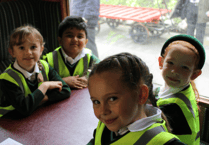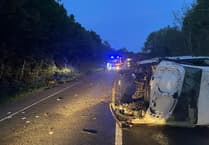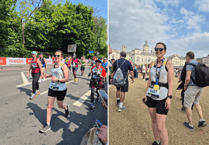STEPPING into Camelford’s former Lloyds bank building, any visitor would feel the deep sense of nostalgia, as the opening of the ‘Now & Then’ exhibition invited locals to take a glimpse of the town’s rich past.
Organised by the dedicated members of the Camelford History and Archive Trust, the Now & Then exhibition, which took place on Monday, October 17, was an introduction to the town’s new micro museum, exhibition room and tourist information centre, which now resides in the old Lloyds bank building after it was offered to the chair of the trust, town councillor Philip Lessels.
Built in the 1930s, the old Lloyds bank building was once home to the offices for the Camelford Rural District Council, and is now serving the town as a museum, holding various artefacts and photos of times past.
Amazed at the transformation of the building, town mayor Rob Rotchell said: “This is absolutely brilliant, and it’s all down to a great group of people who have worked really hard to get this to where it is today. I’d really encourage people to come in and have a look. It’s a really great thing for the town.”
Surrounded by artefacts, from ancient pieces of flint used by old farmers, to vintage photographs of the railway; a collection of spectacles, to a children’s entertainment projector, there was something for everyone to find an interest in.
Cllr Lessels explained to the Post that the contents of the micro museum were mainly donated from the former North Cornwall Museum curator Sally Holden’s collection, as well as photographs from Mrs Nancy Lane and donations from members of the public.
Cllr Lessels said: “It’s through the generosity of the people that this has been possible, from the photographic artefacts to the exhibitions and tourist information centre. Everything donated will be stored. We don’t want any exhibition to go stale; the artefacts that are now in storage will be put on display in the future, so people will come back again and say ‘oh yes, it has changed since we last came’.
He added: “I think what we thought initially, before starting this, was, if we don’t do something, then Camelford’s history will be lost forever.”
Another member of the trust, Diane Taylor, agreed with Cllr Lessels, adding: “Camelford’s past is very important to us. We’ve not only kept it all together, but displayed it for the people who made the history.
“This is all about Camelford’s past, and the people who are here now; they are the ones who have allowed us to collect the artefacts to create the museum, the exhibition and the tourist information centre.
“We’re doing whatever we can do to increase the footfall in the town, and what we’re offering now is for any local groups or communities in the town to get in touch with us if they want to advertise or publicise for free. Anyone wishing to do this can promote themselves in the exhibition room, where we will let them have a table or a space to publicise their groups. We’re also desperately looking for volunteers!”
Within the space of an hour or so after the event opened its doors, the exhibition had already welcomed 20 local people interested in the history of the town, and the members of the trust were excited to see what the rest of the day would bring.
Catharine Little, an enthusiast and collector of antique 3D images and children’s toys, was on hand to show visitors how her interesting and mysterious contraption — a Victorian stereoscope — would have entertained families and children in the days where television and iPhones were a thing of the future.
Catharine said: “I was given this when a lady was wondering what to do with it and came into my shop to see if I was interested in it. We came to an agreement, should we say, and I was thrilled to receive it.”
She showed the Post how the device would work. A Victorian would simply slide the image into a little compartment and would be able to peer closely at the image through a pair of binocular-type magnetised glasses, which would give a 3D effect. The image in the device at the time showed a family sat around a table, with a little dog tucked in within the chairs.
Catharine also presented a collection of colourful strips of images for children, which could be projected on the wall by a ‘magic lantern’ made of polished tin.
She said: “I can imagine a family would use these on a Sunday, sat around the fire. They’d have to be quite well-to-do — normal families around here at the time would have made their own toys and games, but a family that owned something like this would have had to be well-to-do, I would have thought.”
Catharine was delighted with the exhibition. She continued: “The exhibition has really put the heart back into Camelford. We really need to turn things around a bit, but this has shown that people have been working together as a community, and everyone’s been so much help.”
Nancy Lane, wife of the late Harold Lane, the well-known photographer in the area who captured the Camelford he knew many years ago in a series of images, also popped into the exhibition, her husband’s photographs making up a high percentage of the museum’s content.
She told the Post: “It’s absolutely wonderful, and a lot of work. A lot of my husband’s photos are actually here; he made two big albums for Camelford, and the front cover of My Camelford was of the last train to Camelford, which my husband took. He always used to sit and write about Camelford, and a few years ago we had his photos published in a book, which raised over £3,000 for Children’s Hospice.
“This has brought back a lot of lovely memories for people, but it’s such a pity because you throw things away without even thinking about it, and they could mean a lot in the future.”
Sally Holden, who was the curator of the North Cornwall Museum for 40 years until her retirement in 2012, was delighted to see that her collection of artefacts had been given a new lease of life.
Often being given items from Wadebridge, Bodmin and Launceston, she was thrilled to see that the Now & Then exhibition and the new museum was dedicated solely to Camelford.
Sally said: “I had the museum for 40 years, but when dispersing at retirement, the Camelford History and Archive Trust got in contact with me, because they wanted the Camelford things to stay in the town.
“Of course, others have added to the collection — I got things from Wadebridge, Bodmin, Launceston and all sorts of other places around North Cornwall — but we’re very lucky that we’ve had a group that wants to keep the Camelford history going.
“Hopefully this will bring people into the town, as Camelford has suffered since the banks closed, but I think this is very much a community project in Camelford. Although it’s on a smaller scale, the history is now going to be more Camelford centered, and I think nowadays people are more interested in this sort of thing.”
Following the success of the Last Train to Camelford exhibition, which finished on October 15, and raised well over £1,000 from the 165 calendars sold, which will be put towards conservation and other costs for the trust’s projects, Cllr Lessels and the dedicated members of the Camelford History and Archive Trust hope the introduction to the micro museum, exhibition space and tourist information centre, will really take off, allowing residents and visitors to delve into the town’s and their own history.
The museum is open from 10am until 2pm, Monday to Saturday. To volunteer, contact Diane Taylor on 01840 213 433.





This article has no comments yet. Be the first to leave a comment.